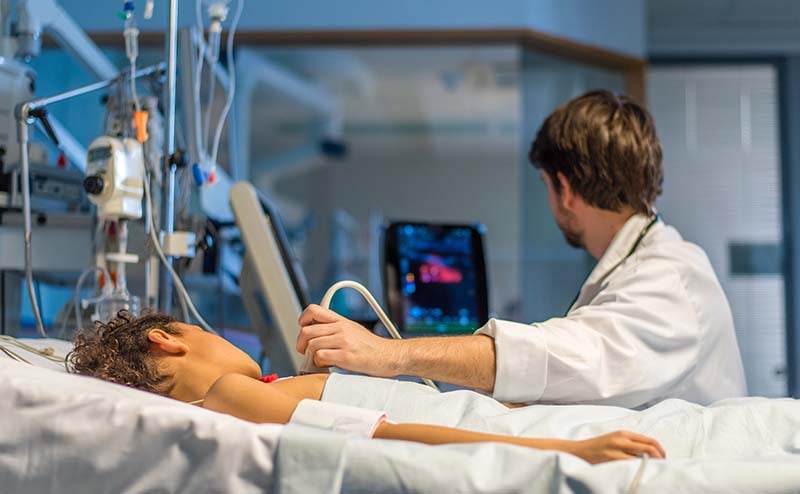Leading health care organizations collaborate and urge physicians to weigh the benefits and risks of imaging and incorporate the recommendations, resources
ITASCA, IL --Emergency medicine clinicians often use advanced imaging tools like ultrasound, computed tomography (CT) and magnetic resonance imaging (MRI)to evaluate injuries and illness in children. A new joint policy statement from the American Academy of Pediatrics, the American College of Emergency Physicians and American College of Radiology offer guidelines for institutions and medical professionals who care for children to make the best use of advanced imaging in the emergency department by weighing benefits and risks.
The policy statement, “Optimizing Advanced Imaging of the Pediatric Patient in the Emergency Department,” and an accompanying technical report are the result of a multidisciplinary collaboration that will be published online on June 27, 2024, in Pediatrics and the Journal of the American College of Radiology. Annals of Emergency Medicine will publish the policy statement on July 18.
Policy statements and technical reports created by AAP are written by medical experts, reflect the latest evidence in the field, and go through several rounds of peer review before being approved by the AAP Board of Directors and published in Pediatrics.
“Technological advances have improved the accuracy, speed and accessibility of advanced imaging, and in the last several decades there has been a dramatic increase in the use of these studies in the emergency department,” said Jennifer R. Marin, MD, MSc, FACEP, FAAP, lead author of the policy statement and member of the AAP Committee on Pediatric Emergency Medicine.
“But many imaging studies are considered to be of low value, meaning the risks outweigh the benefits. More studies aren’t necessarily better and it is important that clinicians consider factors, including the radiation exposure from computed tomography and false-positive and incidental findings that increase downstream testing,” Dr. Marin said. “We know that advanced imaging can also result in longer emergency department stays, and there are risks associated with transport or sedation in an uncooperative child, and financial costs to the health system.”
Aisha Terry, MD, MPH, FACEP, president of ACEP, said, “These guidelines will remind clinicians to routinely weigh any risk associated with pediatric imaging against the benefits. This will ensure that decisions to image and utilize associated support services are made in a timely and appropriate manner, resulting in optimal benefit to our youngest patients. Further, adopting standardized approaches to evaluation and diagnosis using evidence-based guidelines can improve care coordination as well as shared decision-making between clinicians and families.”
The technical report includes a supplement that provides condition-specific imaging recommendations, including clinical guidelines and pathways from several children’s hospitals that can be useful for providers at the point of care.
“This collaborative effort will help raise the quality of pediatric emergency care. It represents a valuable opportunity to raise awareness of evidence-based imaging guidelines such as the ACR Appropriateness Criteria amongst our patient-facing colleagues,” said Michael R Aquino, MD, DABR, MHSc, section head of Pediatric Imaging at the Cleveland Clinic Imaging Institute and director of Pediatric Overnight Emergency Imaging.
Physicians should be familiar with optimal imaging strategies for common pediatric conditions and use publicly available evidence-based guidelines and protocols that are designed to minimize potentially unnecessary imaging and additionally reduce racial and ethnic disparities in imaging delivery.
The AAP, ACEP, and the ACR recommend that emergency departments:
- ensure that appropriate computed tomography protocols and parameters are used for pediatric patients;
- strive to provide ultrasound services as first-line imaging when indicated, such as for appendicitis or nephrolithiasis;
- develop policies for imaging consultation with a pediatric radiologist, general radiologist with expertise in pediatric imaging or pediatric subspecialist to minimize transfers that may require only imaging review.
“One of the easiest ways to optimize advanced imaging in a community emergency department,” says Dr. Marin, “is to defer imaging in children who are going to be transferred to a pediatric referral center regardless of the imaging result, if the result will not alter management prior to or during transfer. Often, there are delays in accessing outside studies, and many studies need to be repeated if not optimally performed or the images were not transferred successfully.”
The policy statement also contains recommendations for using shared decision-making strategies when more than one reasonable choice regarding imaging exists.
 American College of Emergency Physicians
American College of Emergency Physicians







